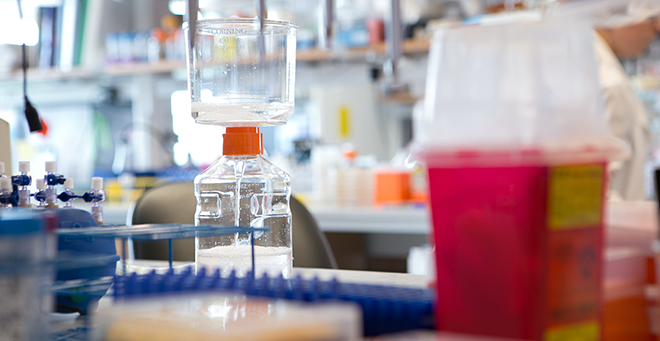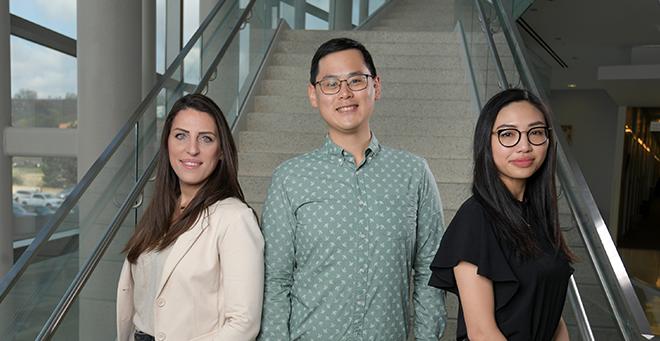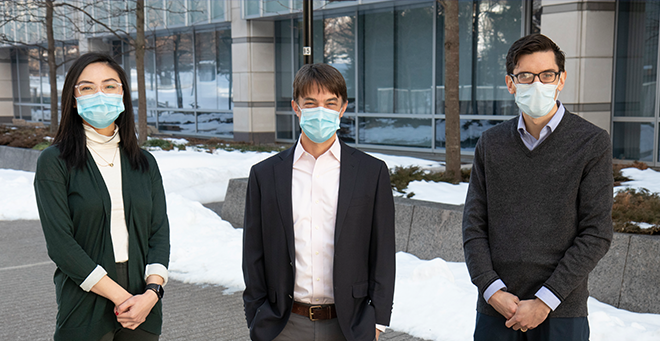
Read Pukkila-Worley, MD, professor of medicine, and MD/PhD student Samantha Tse-Kang
A pair of recently published studies examining immune response in C. elegans reveal broad implications for understanding pathogen detection in higher animals and evolutionary origins of immunity itself.
The research, co-authored by MD/PhD student Samantha “Sammy” Tse-Kang and Read Pukkila-Worley, MD, professor of medicine, uncovered a mechanism of effector-triggered immunity in animals, in which host cells detect infection by sensing the harmful effects of a pathogen rather than simply the presence of a dangerous microbe. The new research details the mechanism of an immune regulator whose role in pathogen sensing is conserved across all organisms.
The papers, which were published simultaneously in the journals Immunity and Cell Reports on Sept. 18, examine a type of immune regulator called SARM, which is required for immune defenses in plants and bacteria. It was not previously known whether these proteins have a role in pathogen sensing in animals. Tse-Kang and her colleagues showed that the SARM homolog in C. elegans is specifically expressed on a cellular compartment in intestinal cells that enables it to respond to pathogen-induced damage to the host and activate protective immune defenses.
“As we went along, we realized that we were thinking about two separate mechanisms, one that activated the host immune response during infection and another that prevented damaging inflammation by restraining the same pathway.”
Tse-Kang said the two papers began with a single question: “What regulates the immune response in C. elegans?”
“These companion papers started from an unbiased genetic screen, and it was not always clear where these stories were progressing. As we went along, we realized that we were thinking about two separate mechanisms, one that activated the host immune response during infection and another that prevented damaging inflammation by restraining the same pathway,” Dr. Pukkila-Worley said. “Sammy was essential to this recognition and the execution of the incredibly detailed and challenging experiments.”
“Our studies show that C. elegans intestinal epithelial cells can identify not only the presence of infectious pathogens, but a pathogen that's actively causing disease, by sensing what we call ‘patterns of pathogenesis,’” Tse-Kang said. “We think this will open up avenues for similar studies in higher order mammals such as mice and humans.”
Tse-Kang and Pukkila-Worley credit the contribution of their former lab member, Nick Peterson, MD, PhD’24. In 2023, Dr. Peterson published a paper in Immunity characterizing a different pattern of pathogenesis in C. elegans. He and his colleagues showed that a metabolite derived from a pathogen is sensed in the host to indicate the toxic potential of an invading pathogen.
Fiachra Humphries, PhD, assistant professor of medicine; Khursheed A. Whani, instructor in medicine; MD/PhD student Amanda Page; and Peterson, are co-authors with Tse-Kang and Pukkila-Worley on the paper published in Immunity identifying TIR-1 as a guard protein in an effector-triggered immune response.
“Some of this was luck, and you need a little bit of luck in science. The rest of it was the result of wonderful conversations in the lab, bouncing ideas off each other. These stories could not have been possible without everyone else involved. It was a team effort,” Tse-Kang said.
Tse-Kang earned her undergraduate degree at Boston College and worked as a research technician at the Ragon Institute of MGH, MIT and Harvard before matriculating at UMass Chan in 2016. She is an inaugural winner of the Robert W. Finberg, MD, Memorial Research Training Award and has received the Ruth L. Kirschstein National Research Service Awards from the National Institutes of Health.
She completed her PhD in April and returned to pursuing her medical degree in July.


